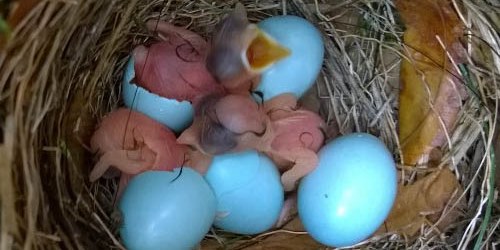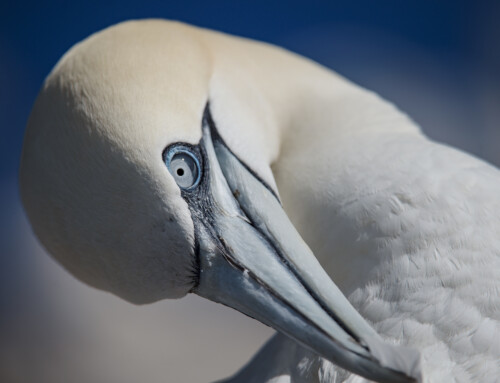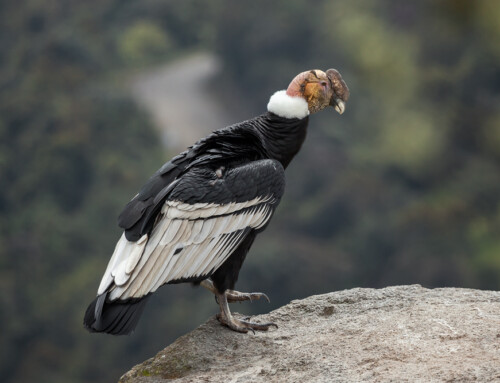Pied Flycatchers do not gain more extra-pair paternity by arriving earlier
LINKED PAPER
Early arrival is not associated with more extra-pair fertilizations in a long-distance migratory bird. Tomotani, B.M., Caglar, E., de la Hera, I., Mateman, A.C. & Visser, M.E. 2017. Journal of Avian Biology. DOI: 10.1111/jav.01317. VIEW
The timing of arrival is an important decision for a migratory bird. For example, if a male bird arrives early he can choose the best breeding territory and have more chances of obtaining a female. Indeed, early arriving males are known to benefit from an overall higher breeding success (Alatalo et al. 1984, Slagsvold 1986, Potti and Montalvo 1991, Canal et al. 2012, Velmala et al. 2015, among others). On the other hand, if they arrive too early, they may face very harsh early-spring conditions (e.g., Møller 1994, Brown and Brown 2000).
We carry out long term studies with a breeding population of European Pied Flycatchers, Ficedula hypoleuca, in the Hoge Veluwe National Park, the Netherlands, to investigate the effects of climate change on timing of annual cycle events. Climate change is known to affect when biological events happen; it is known, for example, to cause advancements in timing of breeding and migration in birds.
To understand the impacts of climate change, we need good measures of fitness to uncover whether the birds can respond and adapt to the rapid changes in their environment. Traditionally, fitness is measured by looking at the number of “recruits”, that is, the number of chicks that become breeding birds in the following year(s). There are other aspects, however, that contribute to the total fitness, and one of these is whether early males are also the ones with more cases of extra-pair paternity (henceforth “EPP”) (Langefors et al. 1998, Møller et al. 2003, Reudink et al. 2009, Cooper et al. 2011). Thus, we wanted to investigate if these early males also benefited from the “bonus” of achieving more EPP (or losing less paternity in their own nests). To discover that, we first observed the dates when male Pied Flycatchers arrived on their Dutch breeding site. We then sampled DNA from all males, females and offspring in order to assess how many chicks these males fostered in their own nests and in other males’ nests. So all birds were genotyped and this information was used to assign the paternity of all chicks to a male and a female.

We found that if a male pairs with a female that lays her eggs early in the season, he will have an increased probability to gain EPP in another nest. However, his arrival date alone does not lead to the same pattern. This was a curious finding because early-arriving males also tend to have females that lay early. This seems to be caused by the large variation in the relation of male arrival and female egg-laying; in other words, early males may still end up with late egg-laying females and vice-versa, blurring any relation between male arrival and gains in EPP.


Another curious finding of our study was related to the males that did not obtain a female during the season, the so-called “bachelors” (we also sampled them). As other studies reported (e.g., Potti and Montalvo 1991, Cooper et al. 2010), males that arrived late had a lower chance of attracting a female and, thus, risking not obtaining any paternity. However, we found out that sometimes a bachelor can obtain some paternity by fertilising an already-paired female. Thus, even if unable to settle their own nest, these bachelors might still father chicks.

To conclude, our study does not support the hypothesis that early arriving males benefit from more EPP. On the contrary, it shows that the component of the male Pied Flycatcher phenology that affects the variation in EPP is the laying date of its female. Therefore, if we want to estimate fitness of arrival dates, our results should not be largely affected when information on EPP is not available.
References and further reading
Alatalo, R.V., Lundberg, A. & Ståhlbrandt, K. 1984. Female mate choice in the Pied Flycatcher Ficedula hypoleuca. Behav. Ecol. Sociobiol. 14: 253–261. VIEW
Brown, C.R. & Brown, M.B. 2000. Weather-mediated natural selection on arrival time in Cliff Swallows (Petrochelidon pyrrhonota). Behav. Ecol. Sociobiol. 47: 339–345. VIEW
Canal, D., Jovani, R. & Potti, J. 2012a. Multiple mating opportunities boost protandry in a pied flycatcher population. Behav. Ecol. Sociobiol. 66: 67–76. VIEW
Cooper, N.W., Murphy, M.T., Redmond, L.J. & Dolan, A.C. 2010. Reproductive correlates of spring arrival date in the Eastern Kingbird Tyrannus tyrannus. J. Ornithol. 152: 143–152. VIEW
Langefors, Å., Hasselquist, D. & von Schantz, T. 1998. Extra-pair fertilizations in the Sedge Warbler. J. Avian Biol. 29: 134–144. VIEW
Møller, A.P., Brohede, J., Cuervo, J.J., de Lope, F. & Primmer, C. 2003. Extrapair paternity in relation to sexual ornamentation, arrival date, and condition in a migratory bird. Behav. Ecol. 14: 707–712. VIEW
Potti, J. & Montalvo, S. 1991. Male arrival and female mate choice in Pied Flycatchers Ficedula hypoleuca in Central Spain. Ornis Scand. 22: 45–54. VIEW
Reudink, M.W., Marra, P.P., Kyser, T.K., Boag, P.T., Langin, K.M. & Ratcliffe, L.M. 2009. Non-breeding season events influence sexual selection in a long-distance migratory bird. Proc. R. Soc. Lond. B Biol. Sci. 276: 1619–1626. VIEW
Slagsvold, T. 1986. Nest site settlement by the Pied Flycatcher: does the female choose her mate for the quality of his house or himself? Ornis Scand. 17: 210–220. VIEW
Velmala, W., Helle, S., Ahola, M.P., Klaassen, M., Lehikoinen, E., Rainio, K., Sirkiä, P.M. & Laaksonen, T. 2015. Natural selection for earlier male arrival to breeding grounds through direct and indirect effects in a migratory songbird. Ecol. Evol. 5: 1205–1213. VIEW
Image credit
Featured image: Pied Flycatcher Ficedula hypoleuca hatchlings in nest © B. Tomotani & I. de la Hera
If you want to write about your research in #theBOUblog, then please see here.





